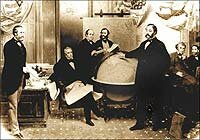
 |
|
||||||||||||||||||||||||
|
Russia's Colony
The Sale of Russian America
Between 1854 and 1856 Russia fought the Crimean War with England and other European nations for access to world maritime commerce. Russia lost the war. In 1855 and 1856 British and French warships attacked and took the town of Petropavlovsk on the east coast of Kamchatka. This raised a question about the security of Russian America. If the Russians could not successfully protect Petropavlovsk against an invading force, would they be able to protect Sitka or Kodiak, or any of the other places in Russian America? By the middle of the 1850s the Russians had gathered information on all of Alaska's known resources. They had failed in their attempt to hunt whales, and mine coal on the Kenai Peninsula, and they had not found enough gold to warrant major mining development. They had gone far up the Yukon River in search of new fur bearers, and faced a dwindling supply. They relied on Aleut labor. In Southeast Alaska they were dependent on the Tlingits for food supplies. In addition, the Tlingit remained powerful, and attempted several times to attack them. In St. Petersburg, the tsar and his advisors began to discuss how they might better supply Russian's American colony, defend it from foreign conquest, and protect it from Indian attacks. These discussions eventually led them to consider whether or not Russian America was a liability. Several advisors pointed out that the fur resources of the Amur River basin in China were unexploited, and that area was easier to defend and cheaper to supply. The tsar and his council decided that the best course of action was to sell Russian America and concentrate on Asia. When that information became public, the United States quickly indicated an interest in the region. Links:
 Signing the Alaska Treaty of Cessation, 30.3.1867 L. to R. Robert S. Chew, Secretary of State (USA) William H. Seward, William Hunter, Mr. Bodisco, Russian Ambassador Baron de Stoeckl, Charles Sumner, Fredrick W. Seward Collection Name: Alaska Library For Russia, the decision to abandon its American colony was a practical one. Alaska was no longer as profitable as it had been, and the challenge of defending the colony against potential enemies was formidable if not impossible. With the sale to the United States, an important chapter in the European colonization of the Americas came to a close. Biographies:
|
|||||||||||||||||
|